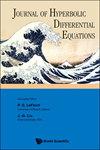Kerr-Newman时空的电磁-引力摄动:Teukolsky和Regge-Wheeler方程
IF 0.5
4区 数学
Q4 MATHEMATICS, APPLIED
引用次数: 4
摘要
推导了电磁-引力耦合扰动下克尔-纽曼时空线性稳定性的方程。这些方程推广了著名的Teukolsky方程对于Kerr的曲率摄动和Regge-Wheeler方程对于Reissner-Nordström的度规摄动。由于钱德拉塞卡所说的“自旋-1和自旋-2场之间耦合的明显不溶性”,克尔-纽曼时空的稳定性无法通过模式中的标准分解得到。由于不可能解耦引力场和电磁场的模式,控制Kerr-Newman线性稳定性的方程以前没有得到。利用应用于Kerr的张量方法,我们得到了Kerr - newman扰动的一组广义Regge-Wheeler方程,该方程适用于用物理空间方法研究线性化稳定性。物理空间分析克服了自旋-1和自旋-2场耦合的问题,是对Kerr-Newman黑洞稳定性的解析证明的第一步。本文章由计算机程序翻译,如有差异,请以英文原文为准。
Electromagnetic-gravitational perturbations of Kerr–Newman spacetime: The Teukolsky and Regge–Wheeler equations
We derive the equations governing the linear stability of Kerr–Newman spacetime to coupled electromagnetic-gravitational perturbations. The equations generalize the celebrated Teukolsky equation for curvature perturbations of Kerr, and the Regge–Wheeler equation for metric perturbations of Reissner–Nordström. Because of the “apparent indissolubility of the coupling between the spin-1 and spin-2 fields”, as put by Chandrasekhar, the stability of Kerr–Newman spacetime cannot be obtained through standard decomposition in modes. Due to the impossibility to decouple the modes of the gravitational and electromagnetic fields, the equations governing the linear stability of Kerr–Newman have not been previously derived. Using a tensorial approach that was applied to Kerr, we produce a set of generalized Regge–Wheeler equations for perturbations of Kerr–Newman, which are suitable for the study of linearized stability by physical space methods. The physical space analysis overcomes the issue of coupling of spin-1 and spin-2 fields and represents the first step towards an analytical proof of the stability of the Kerr–Newman black hole.
求助全文
通过发布文献求助,成功后即可免费获取论文全文。
去求助
来源期刊

Journal of Hyperbolic Differential Equations
数学-物理:数学物理
CiteScore
1.10
自引率
0.00%
发文量
15
审稿时长
24 months
期刊介绍:
This journal publishes original research papers on nonlinear hyperbolic problems and related topics, of mathematical and/or physical interest. Specifically, it invites papers on the theory and numerical analysis of hyperbolic conservation laws and of hyperbolic partial differential equations arising in mathematical physics. The Journal welcomes contributions in:
Theory of nonlinear hyperbolic systems of conservation laws, addressing the issues of well-posedness and qualitative behavior of solutions, in one or several space dimensions.
Hyperbolic differential equations of mathematical physics, such as the Einstein equations of general relativity, Dirac equations, Maxwell equations, relativistic fluid models, etc.
Lorentzian geometry, particularly global geometric and causal theoretic aspects of spacetimes satisfying the Einstein equations.
Nonlinear hyperbolic systems arising in continuum physics such as: hyperbolic models of fluid dynamics, mixed models of transonic flows, etc.
General problems that are dominated (but not exclusively driven) by finite speed phenomena, such as dissipative and dispersive perturbations of hyperbolic systems, and models from statistical mechanics and other probabilistic models relevant to the derivation of fluid dynamical equations.
Convergence analysis of numerical methods for hyperbolic equations: finite difference schemes, finite volumes schemes, etc.
 求助内容:
求助内容: 应助结果提醒方式:
应助结果提醒方式:


